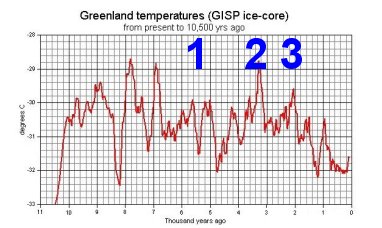|
The
Fanes' saga - Short essays
Climatic variations
Science
today still isn’t able to give a precise answer to the question
“what was the climate on the Fanes’ highlands during
the Bronze and Iron Ages? This both because no local data relevant
to those periods are available, and because several general climatic
indicators derived from different sources are well known, but
reconstructing the actual climate from such indicators involves
factors not yet completely understood which translate into a margin
of inaccuracy. We can state, however, that around 1000 B.C. the
environmental conditions were “getting worse”, i.e.
that the climate was becoming colder and more humid.
The
theoretically most significant palaeoclimatic analysis, because
its samples were collected within the “Fanes area”
is that performed on the flowstone layers in the Bears Cave, that
opens on the Cunturines.
Unfortunately both the speleothems and the bear bones are far
too old (over 40 thousand years!) to provide us with any data
relevant to the period of our interest.
Several
other studies exist, performed with different methods (analysis
of lake sediment layers; pollen analysis in old timber; cave concretions,
etc.) that give us important informations about the climate variations
in the Alps of the past. Unfortunately only a small part of them
covers the Bronze-Iron period adequately, not all of them agree
with each other, and not all of them are accurate enough to generate
a clear picture. A few articles reporting these studies are listed
in Bibliography.
It
seems, anyway, that we can draw the general indication that in
the Metal Ages there have been three warmer-than-present periods
that might have allowed wintering on the Fanes plateaus:
-
The most ancient of them should correspond to the period from
5500 to 5000 years B.P. (before present), thence roundabout the
period when Ötzi, the Similaun Iceman, lived;
- The second period, shorter but warmer, should date to about
3300 years B.P., i.e. in the final stage of the Bronze Age, maybe
a few centuries before the advent of the Iron Age:
- The third one, shorter again and colder than the previous one,
should correspond more or less to the Roman period (2000 years
B.P.).
I’m
enclosing a graph here below, derived from ice drilling in Greenland
and then certainly not linked to local data, but very clear and
easy to read, where what has been stated above can be verified.
The
main scale along X-axis is in thousands of years ranges
from 11,000 years B.P. to present; that on the Y-axis is
in degrees °C and spans from –33 to –28
(obviously with reference to the ice formation temperature
in Greenland; scientists believe that these climatic variations
can be roughly valid for the whole Northern emisphere).
The data are derived from:
http://mclean.ch/climate/Ice_cores.htm
(modified for clarity).
|
 |
|

